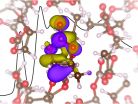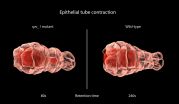(Press-News.org) PHILADELPHIA - (Dec. 19, 2014) - A common polymorphism - a variation in a person's DNA sequence that is found with regularity in the general population - can lead to a chain of events that dictates how a tumor will progress in certain types of cancer, including a form of breast cancer as well as ovarian cancer, according to new research from The Wistar Institute that was published online by the journal Cancer Cell.
The research reveals a more explicit role about the symbiotic relationship humans have with the various bacteria that inhabit our body and their role during tumor progression.
"Our research indicates that interactions between the helpful bacteria in our bodies and immune cells at places situated away from tumors influence systemic responses in the host that alter how these tumors are able to progress," said José Conejo-Garcia, M.D., Ph.D., Associate Professor and Program Leader in the Tumor Microenvironment and Metastasis Program at The Wistar Institute and lead author of the study.
Humans are colonized with trillions of bacteria - known as commensal bacteria because there are benefits to having these bacteria in our bodies - that inhabit the gastrointestinal and respiratory tracts and our skin. These bacteria provide a first line of defense against infection. Recent research has found that interactions between these bacteria and the immune system are critical for providing important defenses against tumors occurring outside of the intestines.
In order for the immune system to recognize commensal as well as microscopic organisms that can cause disease - or pathogens - many of our cells are programmed to recognize pathogen-associated molecular patterns. At least 23% of the general public carries mutations in a group of pathogen recognition receptors called Toll-like receptor (TLR) genes. One of the most abundant polymorphisms, occurring in about 7.5% of the general population, or slightly more than one in fifteen people, which results in loss of function, is in TLR5. Although this polymorphism is found in completely healthy individuals, the people who do carry it are susceptible to illnesses such as Legionnaires disease, urinary tract infections, and bronchopulmonary dysplasia. Knowing that this variant could impact some immune responses, Wistar researchers set out to understand whether TLR5 signaling influences cancer.
The researchers found that TLR5 signaling influences certain types of cancer in different ways and is dependent upon the ability of the tumor to respond to interleukin 6 (IL-6), a small protein that can have both pro-inflammatory and anti-inflammatory properties. In individuals with functional TLR5 expression, commensal bacteria are able to stimulate IL-6 production, greater mobilization of myeloid-derived suppressor cells (MDSCs), which in turn transform gamma delta T cells, a T cell subset that possesses innate-like properties, to produce high amounts of galectin-1, a protein that suppresses antitumor immune activity and hastens tumor progression.
However, the researchers also showed that TLR5 signaling does not always mean that tumors will grow faster. TLR5-deficient mice with tumors that produce low levels of IL-6 have faster tumor progression. In this instance, IL-17, another interleukin closely associated with autoimmune diseases and inflammation, is consistently found in higher levels in TLR5-deficient mice that have tumors, but IL-17 only accelerates cancer when the tumors are unresponsive to IL-6.
Researchers observed these phenomena were dependent upon commensal bacteria. When commensal bacteria were removed with antibiotics, the differences in TLR5-mediated tumor progression were not observed. The researchers noted that the differences in inflammation and progression of tumors are recapitulated in TLR5-responsive and unresponsive patients with ovarian and luminal breast cancer. The researchers performed a survival analysis using data from The Cancer Genome Atlas (TCGA) on patients for whom data on their TLR5 status was known.
"Although independent sets of data and higher numbers of patients are needed, our data suggest that ovarian cancer reflects the evolution of IL-6-dependent tumors, while luminal breast cancer appears to become more aggressive in carriers of the polymorphism that abrogates TLR5 signaling," Conejo-Garcia said.
For ovarian cancer, which is associated with high levels of IL-6, researchers found a significantly higher number of TLR5-deficient patients alive six years after their initial diagnosis compared with patients with TLR5, indicating a correlation between the absence of TLR5 and improved survival. For luminal breast cancer, which is associated with low levels of IL-6, the long-term survival prospects were worse for patients without TLR5.
INFORMATION:
This work was supported by a Cancer Center Support Grant (CA010815. Other grants supporting this study included Grants R01CA157664, R01CA124515, R01CA178687, U54CA151662, and P30CA10815 and by Breast Cancer Alliance and Ovarian Cancer Research Fund Program Project Development awards.
Members of the Conejo-Garcia laboratory who co-authored this study include Melanie R. Rutkowski, Tom L. Stephen, Nikolaos Svoronos, Michael J. Allegrezza, Amelia J. Tesone, Alfredo Perales-Puchalt, Eva Brencicova, Ximena Escovar-Fadul, Jenny M. Nguyen. Other co-authors included Rugang Zhang, another researcher at the Wistar Institute; Mark. G. Cadungog from the Helen F. Graham Cancer Center; Mariana Salatino and Gabriel A. Rabinovich from Laboratorio de Immunopatologia, Buenos Aires, Argentina; and Julia Tchou, and from the University of Pennsylvania.
The Wistar Institute is an international leader in biomedical research with special expertise in cancer research and vaccine development. Founded in 1892 as the first independent nonprofit biomedical research institute in the country, Wistar has long held the prestigious Cancer Center designation from the National Cancer Institute. The Institute works actively to ensure that research advances move from the laboratory to the clinic as quickly as possible. The Wistar Institute: Today's Discoveries - Tomorrow's Cures. On the Web at http://www.wistar.org
(Edmonton) For millions of people around the world, televised medical talk shows have become a daily viewing ritual. Programs such as The Dr. Oz Show and The Doctors have attracted massive followings as charismatic hosts discuss new medical research and therapies while offering viewers their own recommendations for better health. For show producers it's a winning ratings formula, but for viewers eager for a healthier life, the results aren't so clear cut.
"The research supporting any of these recommendations is frequently absent, contradictory or of poor quality," says ...
Women whose loved ones are critical of their weight tend to put on even more pounds, says a new study on the way people's comments affect our health.
Professor Christine Logel from Renison University College at the University of Waterloo led the study, which appears in the December issue of the journal Personal Relationships.
"When we feel bad about our bodies, we often turn to loved ones--families, friends and romantic partners--for support and advice. How they respond can have a bigger effect than we might think," said Professor Logel, who teaches social development ...
WASHINGTON D.C., December 19, 2014 - Researchers at Montana State University and Brandenburg University of Applied Sciences in Germany have created a simple mathematical model based on optical measurements that explains the stunning colors of Yellowstone National Park's hot springs and can visually recreate how they appeared years ago, before decades of tourists contaminated the pools with make-a-wish coins and other detritus.
The model, and stunning pictures of the springs, appear today in the journal Applied Optics, which is published by The Optical Society (OSA).
If ...
Despite showing interest in web or mobile apps to help manage their Type 2 diabetes, only a small number of older adults actually use them, says a new study from the University of Waterloo. Approximately 2.2 million Canadians are living with Type 2 diabetes, 2 million of whom are age 50 or older.
The study, which appears in the online edition of the Journal of Diabetes Science and Technology, found that although more than 90 per cent of research participants owned a computer or had daily Internet access, just 18 per cent used applications on this technology to help manage ...
The lithium-ion batteries that mobilize our electronic devices need to be improved if they are to power electric vehicles or
store electrical energy for the grid. Berkeley Lab researchers looking for a better understanding of liquid electrolyte may have found a pathway forward. A team led by Richard Saykally, a chemist with Berkeley Lab's Chemical Sciences Division, David Prendergast, a theorist with Berkeley Lab's Molecular Foundry, and Steven Harris, a chemist with the Lab's Materials Sciences Division, found surprising results in the first X-ray absorption spectroscopy ...
It's like a scene from a gamer's wildest dreams: 12 high-definition, 55-inch 3D televisions all connected to a computer capable of supporting high-end, graphics-intensive gaming.
On the massive screen, images are controlled by a Wii remote that interacts with a Kinnect-like Bluetooth device (called SmartTrack), while 3D glasses worn by the user create dizzying added dimensions.
But this real-life, computer-powered mega TV is not for gaming. It's for engineering.
Welcome to Brigham Young University's VuePod, a 3D immersive visualization environment run by BYU's Department ...
New research indicates that reducing emergency surgery for three common procedures by 10 percent could cut $1 billion in health care costs over 10 years.
As hospitals and health systems increasingly focus on addressing the rising cost of health care in the United States, and with the expense of surgical care playing a major role, physician researchers and others across the healthcare industry are working to identify innovative ways to reduce surgical costs.
In new findings published online in the journal Annals of Surgery on December 19, 2014, researchers determined ...
Researchers from the University of Southampton have revealed a breakthrough in optical fibre communications.
Academics from the University's Optoelectronics Research Centre (ORC) have collaborated with colleagues at Eblana Photonics Inc, in Ireland, to develop an approach that enables direct modulation of laser currents to be used to generate highly advanced modulation format signals.
The research, published in the journal Nature Communications, explores a radically new approach to the generation of spectrally-efficient advanced modulation format signals as required ...
Carnivorous plants catch and digest tiny animals in order and derive benefits for their nutrition. Interestingly the trend towards vegetarianism seems to overcome carnivorous plants as well. The aquatic carnivorous bladderwort, which can be found in many lakes and ponds worldwide, does not only gain profit from eating little animals but also by consuming algae and pollen grains. This results in survival in aquatic habitats where prey animals are rare, and in increased fitness if the animals and algae are caught in a well-balanced diet. An Austrian research group around ...
Researchers at the Mechanobiology Institute (MBI), National University of Singapore (NUS) have identified a novel mechanosensitive regulation of epithelial tube contraction. These findings are published on 19 December 2014 in Current Biology (Pei Yi Tan and Ronen Zaidel-Bar. Transient membrane localization of SPV-1 drives cyclical actomyosin contractions in the C. elegans spermatheca, Current Biology, 19 Dec 2014, doi: 10.1016/j.cub.2014.11.033)
Regulating tube constriction
Many of the fundamental processes of life rely on biological structures known as epithelial ...






